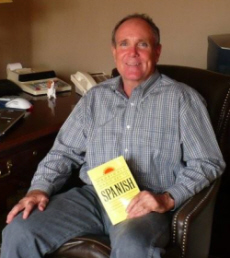PERFECT SPANISH UNCERTAINTIES

There will always be plenty of Spanish language topics to write about. There are so many! Sometimes it takes a while to decide on the next best one. I also have to feel I know a subject well enough to write about it. And believe me, there are some I don’t. Noticing the (unexpected) popularity of the article , on the present subjunctive ("Spanish Hopes, Desires and Uncertainties"), it gave me the idea for this one. The present perfect subjunctive. If you have been following along with these lessons, you have already been introduced to the present subjunctive, and two of the perfect tenses, the present perfect, ("A Very Perfect Spanish Tense"), and the future perfect, ("Your Future is also Perfect"). If you feel comfortable with these past lessons, you will have no problem in understanding the present perfect subjunctive. The present perfect subjunctive works the same way as all perfect tenses. The only difference is it has a subjunctive element. As you recall, ‘perfect’ sentences have two parts, one using their respective conjugations of the verb ‘haber’, to have done something, and the second, using a past participle (done, made, read, seen, etc.) to indicate what has been done. The subjunctive element in a present perfect sentence is some uncertainty, desire, or hope, and refers to something that may or MAY NOT have happened.
If your memory of perfect tenses and the subjunctive has faded a little, you may want to go back and review the examples in the lessons mentioned above. Also, in the below examples, keep an eye out for a few direct object pronouns ("Direct to Pronouns"), thrown in for good measure.
First let’s look at the conjugation of haber in the subjunctive form:
Haya- I, you, he, she it, may have done something, formal.
Hayas – you, may have done something, informal.
Hayan- They, may have done something.
Hayamos- We, may have done something.
Now, take a look at these examples comparing the present perfect to the present perfect subjunctive:
She has done the work. – Ella ha hecho el trabajo.
I hope that she has done the work. – Espero que haya hecho el trabajo.
The first sentence is only a statement. No hope or desire there. So the present form of haber is used, ha. The hope (and desire) that she has done the work in the second sentence makes it subjunctive. Therefore, the subjunctive form of haber, haya, has to be used. The second part of both sentences uses the same past participle, hecho, of the verb hacer, to make or do.
Here are a few more:
The (male) dog. She doubts (that) he has seen it. – Duda que lo haya visto.
It may be that he has (already) done the work. Puede ser que ya haya hecho el trabajo.
It’s possible (that) we have been here before. Es posible que hayamos estado aquí antes.
It is a miracle (that) she woke up so early (herself). Es un milagro que se haya despertado tan temprano.
Do you see why these are subjunctive and perfect sentences? The first part, all indicating some kind of doubt, uncertainty and or desire that something has been done, sets in motion the subjunctive. And that something that might have happened makes them perfect sentences. Therefore, they all have the subjunctive form of haber and a past participle.
Also, did you see the use of the direct object pronoun (lo) in the first example, and the reflexive pronoun (se) in the last example? And note the last example is subjunctive because it is an impersonal opinion. Her getting up so early may or may not of been due to a miracle, and the term miracle is very abstract.
The present perfect subjunctive can also be used to state an uncompleted action. This kind of sentence always lends itself to the subjunctive. Many times these types of sentences will include the ordinary future tense. Refer back to the articles "Your Future Is Bright", Part 1 and Part 2. if you would like to review the future tense.
Take a look at these examples indicating an uncompleted action in the present perfect subjunctive:
I will believe it when I have seen it. – Lo creeré cuando lo haya visto.
Johnny will play golf this morning after his friends have arrived. – Johnny jugará golf esta mañana después de que sus amigos hayan llegado.
Sheila will travel to Panamá today after she has eaten lunch. – Sheila viajará a Panamá después de haya almorzado.
The television. We can watch it after they have fixed it. La podemos mirar después de que la hayan arreglado.
All of the above talk about an action that will not be completed until something else has taken place. That something else may or may not happen. Always subjunctive.
With this lesson we have been introduced to the basics of a new area of Spanish, the present perfect subjunctive. We have also reviewed several other tenses, the present subjunctive, the present perfect, and the future tense. And, we saw again the use of direct object pronouns, a reflexive verb, with it’s pronoun (despertar(se)), and the use of past participles.
This is, after all what learning Spanish is all about. Pushing forward into new, often difficult areas, building on what we already know, and a lot of review. But keep in mind that we can study lessons and read about Spanish theory all day long. That is important, and it does help. But this alone will not enable us to actually speak and understand Spanish. So force yourself to practice live conversation. No excuse not to find opportunity in Panamá.
 Hope this helps!
Hope this helps!
Fred
